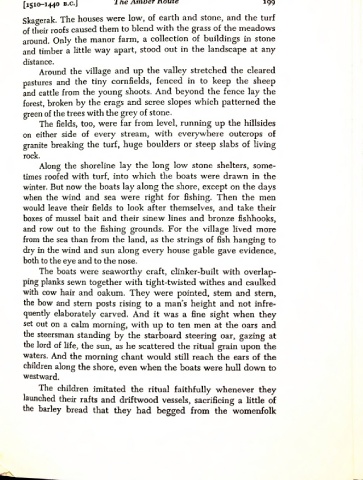Page 238 - Four Thousand Years Ago by Geoffrey Bibby
P. 238
[1510-1440 b.c.J iMAfwernouie 199
Skagerak. The houses were low, of earth and stone, and the turf
of their roofs caused them to blend with the grass of the meadows
around. Only the manor farm, a collection of buildings in stone
and timber a little way apart, stood out in the landscape at any
distance.
Around the village and up the valley stretched the cleared
pastures and the tiny cornfields, fenced in to keep the sheep
and cattle from the young shoots. And beyond the fence lay the
forest, broken by the crags and scree slopes which patterned the
green of the trees with the grey of stone.
The fields, too, were far from level, running up the hillsides
on either side of every stream, with everywhere outcrops of
granite breaking the turf, huge boulders or steep slabs of living
rock.
Along the shoreline lay the long low stone shelters, some
times roofed with turf, into which the boats were drawn in the
winter. But now the boats lay along the shore, except on the days
when the wind and sea were right for fishing. Then the men
would leave their fields to look after themselves, and take their
boxes of mussel bait and their sinew lines and bronze fishhooks,
and row out to the fishing grounds. For the village lived more
from the sea than from the land, as the strings of fish hanging to
dry in the wind and sun along every house gable gave evidence,
both to the eye and to the nose.
The boats were seaworthy craft, clinker-built with overlap
ping planks sewn together with tight-twisted withes and caulked
with cow hair and oakum. They were pointed, stem and stern,
the bow and stem posts rising to a man’s height and not infre
quently elaborately carved. And it was a fine sight when they
set out on a calm morning, with up to ten men at the oars and
the steersman standing by the starboard steering oar, gazing at
the lord of fife, the sun, as he scattered the ritual grain upon the
waters. And the morning chant would still reach the ears of the
children along the shore, even when the boats were hull down to
westward.
The children imitated the ritual faithfully whenever they
launched their rafts and driftwood vessels, sacrificing a little of
the barley bread that they had begged from the womenfolk

